A Literature Review: Faculty Acceptance of Technology for Education
VerifiedAdded on 2021/04/16
|8
|2149
|29
Literature Review
AI Summary
This literature review examines the factors influencing faculty acceptance of technology for online professional development within higher education. It explores the impact of information technology on education, highlighting the importance of understanding technology acceptance and adoption. The review analyzes various studies, including the Technology Acceptance Model (TAM), to identify key factors such as perceived usefulness, ease of use, and individual intentions. It discusses how faculty attitudes, skills, and access to resources affect their willingness to integrate technology into teaching practices. The review also considers the role of training, infrastructure, and the broader implications for professional development. The Technology Acceptance Model (TAM) is presented as a central theoretical framework for understanding user behavior towards technology, and the limitations of TAM are also discussed. The review emphasizes the importance of addressing faculty concerns and providing support to facilitate successful technology integration in higher education.
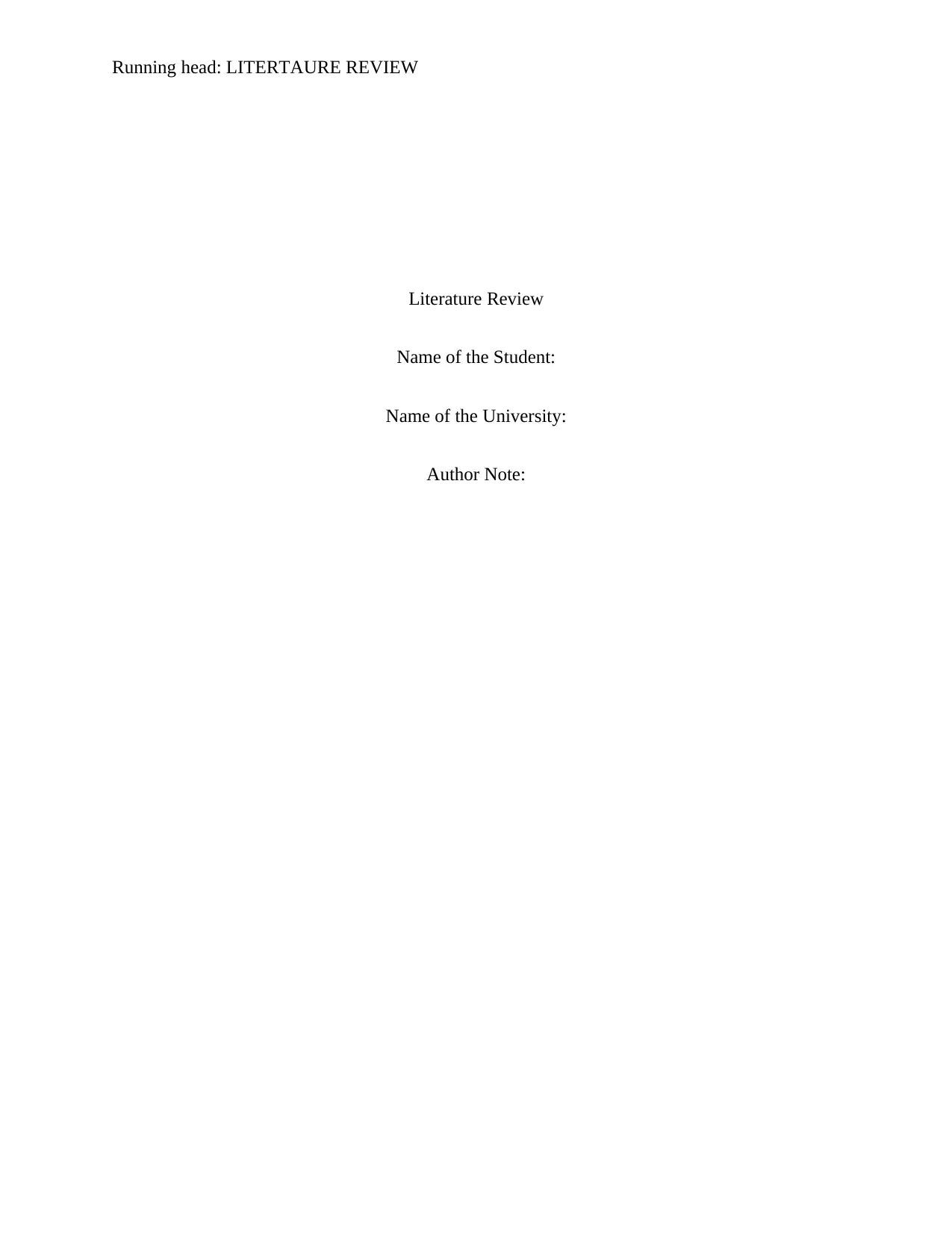
Running head: LITERTAURE REVIEW
Literature Review
Name of the Student:
Name of the University:
Author Note:
Literature Review
Name of the Student:
Name of the University:
Author Note:
Paraphrase This Document
Need a fresh take? Get an instant paraphrase of this document with our AI Paraphraser
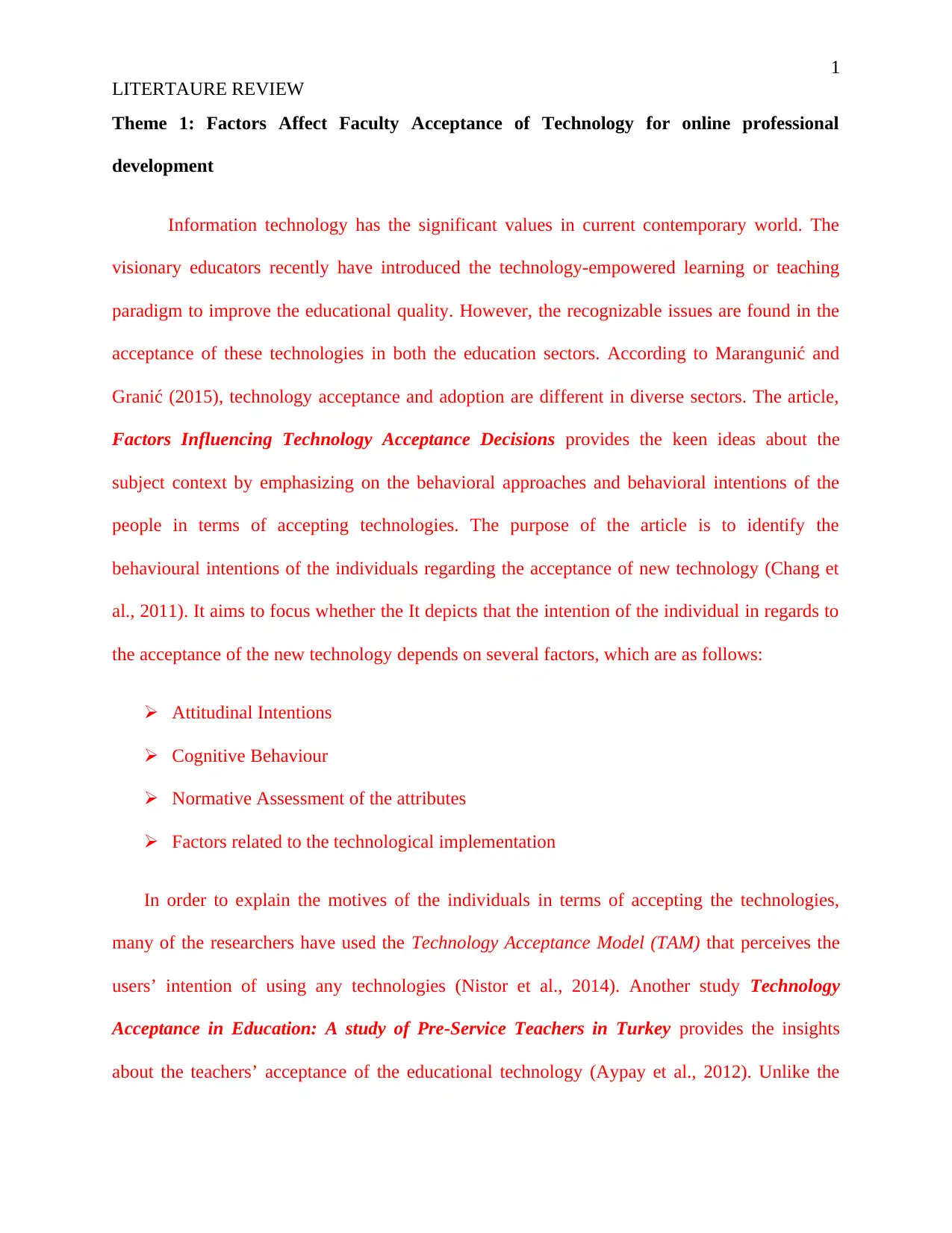
1
LITERTAURE REVIEW
Theme 1: Factors Affect Faculty Acceptance of Technology for online professional
development
Information technology has the significant values in current contemporary world. The
visionary educators recently have introduced the technology-empowered learning or teaching
paradigm to improve the educational quality. However, the recognizable issues are found in the
acceptance of these technologies in both the education sectors. According to Marangunić and
Granić (2015), technology acceptance and adoption are different in diverse sectors. The article,
Factors Influencing Technology Acceptance Decisions provides the keen ideas about the
subject context by emphasizing on the behavioral approaches and behavioral intentions of the
people in terms of accepting technologies. The purpose of the article is to identify the
behavioural intentions of the individuals regarding the acceptance of new technology (Chang et
al., 2011). It aims to focus whether the It depicts that the intention of the individual in regards to
the acceptance of the new technology depends on several factors, which are as follows:
Attitudinal Intentions
Cognitive Behaviour
Normative Assessment of the attributes
Factors related to the technological implementation
In order to explain the motives of the individuals in terms of accepting the technologies,
many of the researchers have used the Technology Acceptance Model (TAM) that perceives the
users’ intention of using any technologies (Nistor et al., 2014). Another study Technology
Acceptance in Education: A study of Pre-Service Teachers in Turkey provides the insights
about the teachers’ acceptance of the educational technology (Aypay et al., 2012). Unlike the
LITERTAURE REVIEW
Theme 1: Factors Affect Faculty Acceptance of Technology for online professional
development
Information technology has the significant values in current contemporary world. The
visionary educators recently have introduced the technology-empowered learning or teaching
paradigm to improve the educational quality. However, the recognizable issues are found in the
acceptance of these technologies in both the education sectors. According to Marangunić and
Granić (2015), technology acceptance and adoption are different in diverse sectors. The article,
Factors Influencing Technology Acceptance Decisions provides the keen ideas about the
subject context by emphasizing on the behavioral approaches and behavioral intentions of the
people in terms of accepting technologies. The purpose of the article is to identify the
behavioural intentions of the individuals regarding the acceptance of new technology (Chang et
al., 2011). It aims to focus whether the It depicts that the intention of the individual in regards to
the acceptance of the new technology depends on several factors, which are as follows:
Attitudinal Intentions
Cognitive Behaviour
Normative Assessment of the attributes
Factors related to the technological implementation
In order to explain the motives of the individuals in terms of accepting the technologies,
many of the researchers have used the Technology Acceptance Model (TAM) that perceives the
users’ intention of using any technologies (Nistor et al., 2014). Another study Technology
Acceptance in Education: A study of Pre-Service Teachers in Turkey provides the insights
about the teachers’ acceptance of the educational technology (Aypay et al., 2012). Unlike the
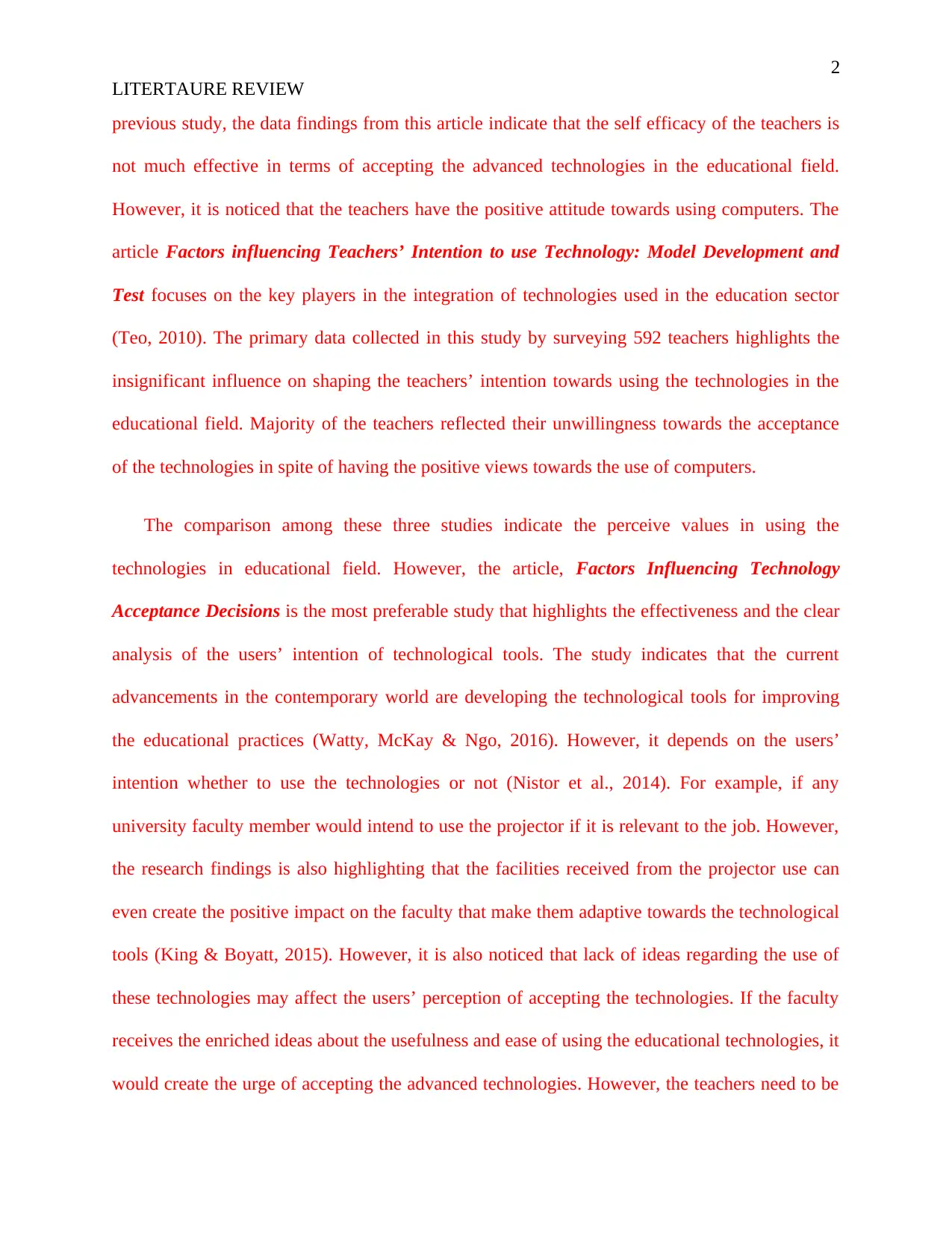
2
LITERTAURE REVIEW
previous study, the data findings from this article indicate that the self efficacy of the teachers is
not much effective in terms of accepting the advanced technologies in the educational field.
However, it is noticed that the teachers have the positive attitude towards using computers. The
article Factors influencing Teachers’ Intention to use Technology: Model Development and
Test focuses on the key players in the integration of technologies used in the education sector
(Teo, 2010). The primary data collected in this study by surveying 592 teachers highlights the
insignificant influence on shaping the teachers’ intention towards using the technologies in the
educational field. Majority of the teachers reflected their unwillingness towards the acceptance
of the technologies in spite of having the positive views towards the use of computers.
The comparison among these three studies indicate the perceive values in using the
technologies in educational field. However, the article, Factors Influencing Technology
Acceptance Decisions is the most preferable study that highlights the effectiveness and the clear
analysis of the users’ intention of technological tools. The study indicates that the current
advancements in the contemporary world are developing the technological tools for improving
the educational practices (Watty, McKay & Ngo, 2016). However, it depends on the users’
intention whether to use the technologies or not (Nistor et al., 2014). For example, if any
university faculty member would intend to use the projector if it is relevant to the job. However,
the research findings is also highlighting that the facilities received from the projector use can
even create the positive impact on the faculty that make them adaptive towards the technological
tools (King & Boyatt, 2015). However, it is also noticed that lack of ideas regarding the use of
these technologies may affect the users’ perception of accepting the technologies. If the faculty
receives the enriched ideas about the usefulness and ease of using the educational technologies, it
would create the urge of accepting the advanced technologies. However, the teachers need to be
LITERTAURE REVIEW
previous study, the data findings from this article indicate that the self efficacy of the teachers is
not much effective in terms of accepting the advanced technologies in the educational field.
However, it is noticed that the teachers have the positive attitude towards using computers. The
article Factors influencing Teachers’ Intention to use Technology: Model Development and
Test focuses on the key players in the integration of technologies used in the education sector
(Teo, 2010). The primary data collected in this study by surveying 592 teachers highlights the
insignificant influence on shaping the teachers’ intention towards using the technologies in the
educational field. Majority of the teachers reflected their unwillingness towards the acceptance
of the technologies in spite of having the positive views towards the use of computers.
The comparison among these three studies indicate the perceive values in using the
technologies in educational field. However, the article, Factors Influencing Technology
Acceptance Decisions is the most preferable study that highlights the effectiveness and the clear
analysis of the users’ intention of technological tools. The study indicates that the current
advancements in the contemporary world are developing the technological tools for improving
the educational practices (Watty, McKay & Ngo, 2016). However, it depends on the users’
intention whether to use the technologies or not (Nistor et al., 2014). For example, if any
university faculty member would intend to use the projector if it is relevant to the job. However,
the research findings is also highlighting that the facilities received from the projector use can
even create the positive impact on the faculty that make them adaptive towards the technological
tools (King & Boyatt, 2015). However, it is also noticed that lack of ideas regarding the use of
these technologies may affect the users’ perception of accepting the technologies. If the faculty
receives the enriched ideas about the usefulness and ease of using the educational technologies, it
would create the urge of accepting the advanced technologies. However, the teachers need to be
⊘ This is a preview!⊘
Do you want full access?
Subscribe today to unlock all pages.

Trusted by 1+ million students worldwide

3
LITERTAURE REVIEW
skilled enough in using and applying these technologies in their classroom learning. Obtaining
the enriched ideas about the appropriate use of the technologies would lead the faculty towards
accepting the technologies.
It has been observed that the lack of knowledge related to the use of new technologies
prevents the teachers’ intentions in using the technologies while teaching the students. If they are
knowledgeable and skilled enough about the use and benefits of such advanced technological
solution, it would influence them to utilize the method more significantly. However, in the
professional field, the effects of highly advanced technologies are quite observable. In fact, it can
be stated that the use of these advanced form of technologies would help in developing the
professional careers as well (Watty, McKay & Ngo, 2016). The study recognizes that the
teachers often require the appropriate and beneficial training session (John, 2015). The improved
knowledge would positively impact on the intentions of the faculty in using the new
technologies. As a result, it would turn out to be much beneficial for their professional
development. On the other hand, the availability of the proper resources and infrastructure for
utilizing these technologies also has the much significance in the acceptance level of the faculty.
Theme 2: The Technology Acceptance Model (TAM) as Theoretical Framework
The Technology Acceptance Model (TAM) was first introduced by Davis in the year of
1989 to develop the understanding about the prediction of the users’ intention of using
technologies. The TAM model depicts two different factors, such as the perceived usefulness
and perceived ease of use (Watty, McKay & Ngo, 2016). The extensive research on this
theoretical framework verifies the intentions of the individuals in terms of accepting the
technological use in different information systems. Concentrating on the studies of Davies, Baran
LITERTAURE REVIEW
skilled enough in using and applying these technologies in their classroom learning. Obtaining
the enriched ideas about the appropriate use of the technologies would lead the faculty towards
accepting the technologies.
It has been observed that the lack of knowledge related to the use of new technologies
prevents the teachers’ intentions in using the technologies while teaching the students. If they are
knowledgeable and skilled enough about the use and benefits of such advanced technological
solution, it would influence them to utilize the method more significantly. However, in the
professional field, the effects of highly advanced technologies are quite observable. In fact, it can
be stated that the use of these advanced form of technologies would help in developing the
professional careers as well (Watty, McKay & Ngo, 2016). The study recognizes that the
teachers often require the appropriate and beneficial training session (John, 2015). The improved
knowledge would positively impact on the intentions of the faculty in using the new
technologies. As a result, it would turn out to be much beneficial for their professional
development. On the other hand, the availability of the proper resources and infrastructure for
utilizing these technologies also has the much significance in the acceptance level of the faculty.
Theme 2: The Technology Acceptance Model (TAM) as Theoretical Framework
The Technology Acceptance Model (TAM) was first introduced by Davis in the year of
1989 to develop the understanding about the prediction of the users’ intention of using
technologies. The TAM model depicts two different factors, such as the perceived usefulness
and perceived ease of use (Watty, McKay & Ngo, 2016). The extensive research on this
theoretical framework verifies the intentions of the individuals in terms of accepting the
technological use in different information systems. Concentrating on the studies of Davies, Baran
Paraphrase This Document
Need a fresh take? Get an instant paraphrase of this document with our AI Paraphraser
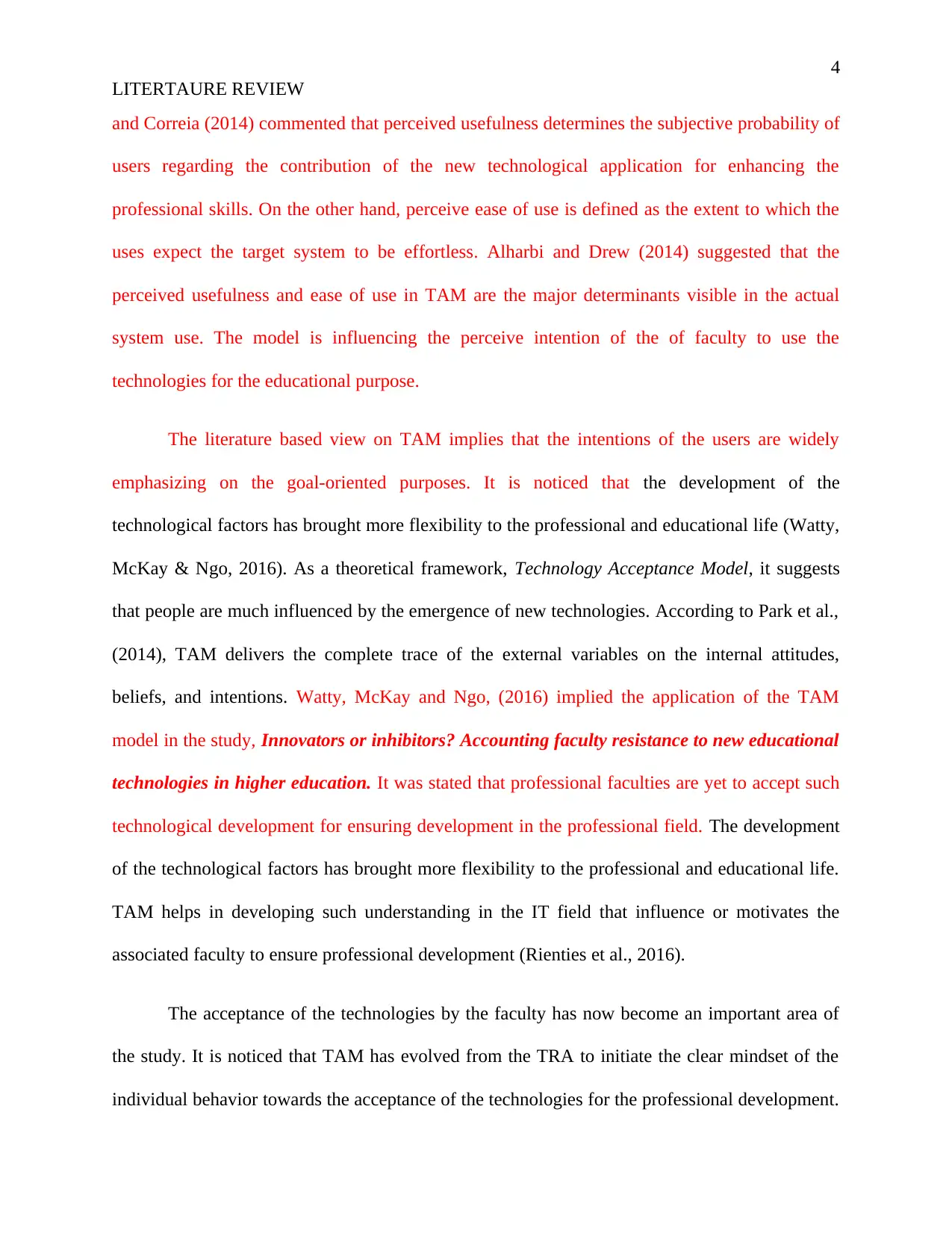
4
LITERTAURE REVIEW
and Correia (2014) commented that perceived usefulness determines the subjective probability of
users regarding the contribution of the new technological application for enhancing the
professional skills. On the other hand, perceive ease of use is defined as the extent to which the
uses expect the target system to be effortless. Alharbi and Drew (2014) suggested that the
perceived usefulness and ease of use in TAM are the major determinants visible in the actual
system use. The model is influencing the perceive intention of the of faculty to use the
technologies for the educational purpose.
The literature based view on TAM implies that the intentions of the users are widely
emphasizing on the goal-oriented purposes. It is noticed that the development of the
technological factors has brought more flexibility to the professional and educational life (Watty,
McKay & Ngo, 2016). As a theoretical framework, Technology Acceptance Model, it suggests
that people are much influenced by the emergence of new technologies. According to Park et al.,
(2014), TAM delivers the complete trace of the external variables on the internal attitudes,
beliefs, and intentions. Watty, McKay and Ngo, (2016) implied the application of the TAM
model in the study, Innovators or inhibitors? Accounting faculty resistance to new educational
technologies in higher education. It was stated that professional faculties are yet to accept such
technological development for ensuring development in the professional field. The development
of the technological factors has brought more flexibility to the professional and educational life.
TAM helps in developing such understanding in the IT field that influence or motivates the
associated faculty to ensure professional development (Rienties et al., 2016).
The acceptance of the technologies by the faculty has now become an important area of
the study. It is noticed that TAM has evolved from the TRA to initiate the clear mindset of the
individual behavior towards the acceptance of the technologies for the professional development.
LITERTAURE REVIEW
and Correia (2014) commented that perceived usefulness determines the subjective probability of
users regarding the contribution of the new technological application for enhancing the
professional skills. On the other hand, perceive ease of use is defined as the extent to which the
uses expect the target system to be effortless. Alharbi and Drew (2014) suggested that the
perceived usefulness and ease of use in TAM are the major determinants visible in the actual
system use. The model is influencing the perceive intention of the of faculty to use the
technologies for the educational purpose.
The literature based view on TAM implies that the intentions of the users are widely
emphasizing on the goal-oriented purposes. It is noticed that the development of the
technological factors has brought more flexibility to the professional and educational life (Watty,
McKay & Ngo, 2016). As a theoretical framework, Technology Acceptance Model, it suggests
that people are much influenced by the emergence of new technologies. According to Park et al.,
(2014), TAM delivers the complete trace of the external variables on the internal attitudes,
beliefs, and intentions. Watty, McKay and Ngo, (2016) implied the application of the TAM
model in the study, Innovators or inhibitors? Accounting faculty resistance to new educational
technologies in higher education. It was stated that professional faculties are yet to accept such
technological development for ensuring development in the professional field. The development
of the technological factors has brought more flexibility to the professional and educational life.
TAM helps in developing such understanding in the IT field that influence or motivates the
associated faculty to ensure professional development (Rienties et al., 2016).
The acceptance of the technologies by the faculty has now become an important area of
the study. It is noticed that TAM has evolved from the TRA to initiate the clear mindset of the
individual behavior towards the acceptance of the technologies for the professional development.
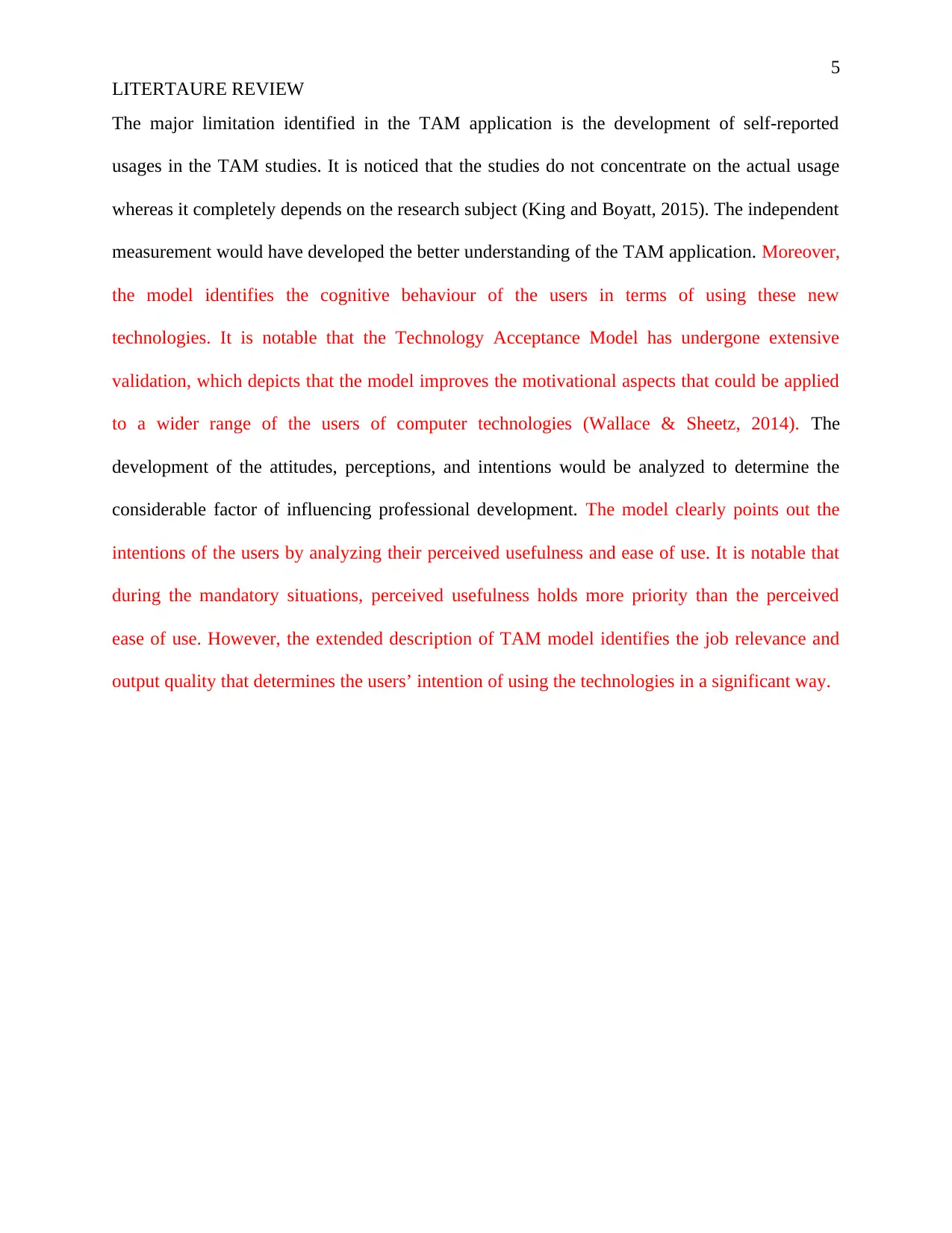
5
LITERTAURE REVIEW
The major limitation identified in the TAM application is the development of self-reported
usages in the TAM studies. It is noticed that the studies do not concentrate on the actual usage
whereas it completely depends on the research subject (King and Boyatt, 2015). The independent
measurement would have developed the better understanding of the TAM application. Moreover,
the model identifies the cognitive behaviour of the users in terms of using these new
technologies. It is notable that the Technology Acceptance Model has undergone extensive
validation, which depicts that the model improves the motivational aspects that could be applied
to a wider range of the users of computer technologies (Wallace & Sheetz, 2014). The
development of the attitudes, perceptions, and intentions would be analyzed to determine the
considerable factor of influencing professional development. The model clearly points out the
intentions of the users by analyzing their perceived usefulness and ease of use. It is notable that
during the mandatory situations, perceived usefulness holds more priority than the perceived
ease of use. However, the extended description of TAM model identifies the job relevance and
output quality that determines the users’ intention of using the technologies in a significant way.
LITERTAURE REVIEW
The major limitation identified in the TAM application is the development of self-reported
usages in the TAM studies. It is noticed that the studies do not concentrate on the actual usage
whereas it completely depends on the research subject (King and Boyatt, 2015). The independent
measurement would have developed the better understanding of the TAM application. Moreover,
the model identifies the cognitive behaviour of the users in terms of using these new
technologies. It is notable that the Technology Acceptance Model has undergone extensive
validation, which depicts that the model improves the motivational aspects that could be applied
to a wider range of the users of computer technologies (Wallace & Sheetz, 2014). The
development of the attitudes, perceptions, and intentions would be analyzed to determine the
considerable factor of influencing professional development. The model clearly points out the
intentions of the users by analyzing their perceived usefulness and ease of use. It is notable that
during the mandatory situations, perceived usefulness holds more priority than the perceived
ease of use. However, the extended description of TAM model identifies the job relevance and
output quality that determines the users’ intention of using the technologies in a significant way.
⊘ This is a preview!⊘
Do you want full access?
Subscribe today to unlock all pages.

Trusted by 1+ million students worldwide
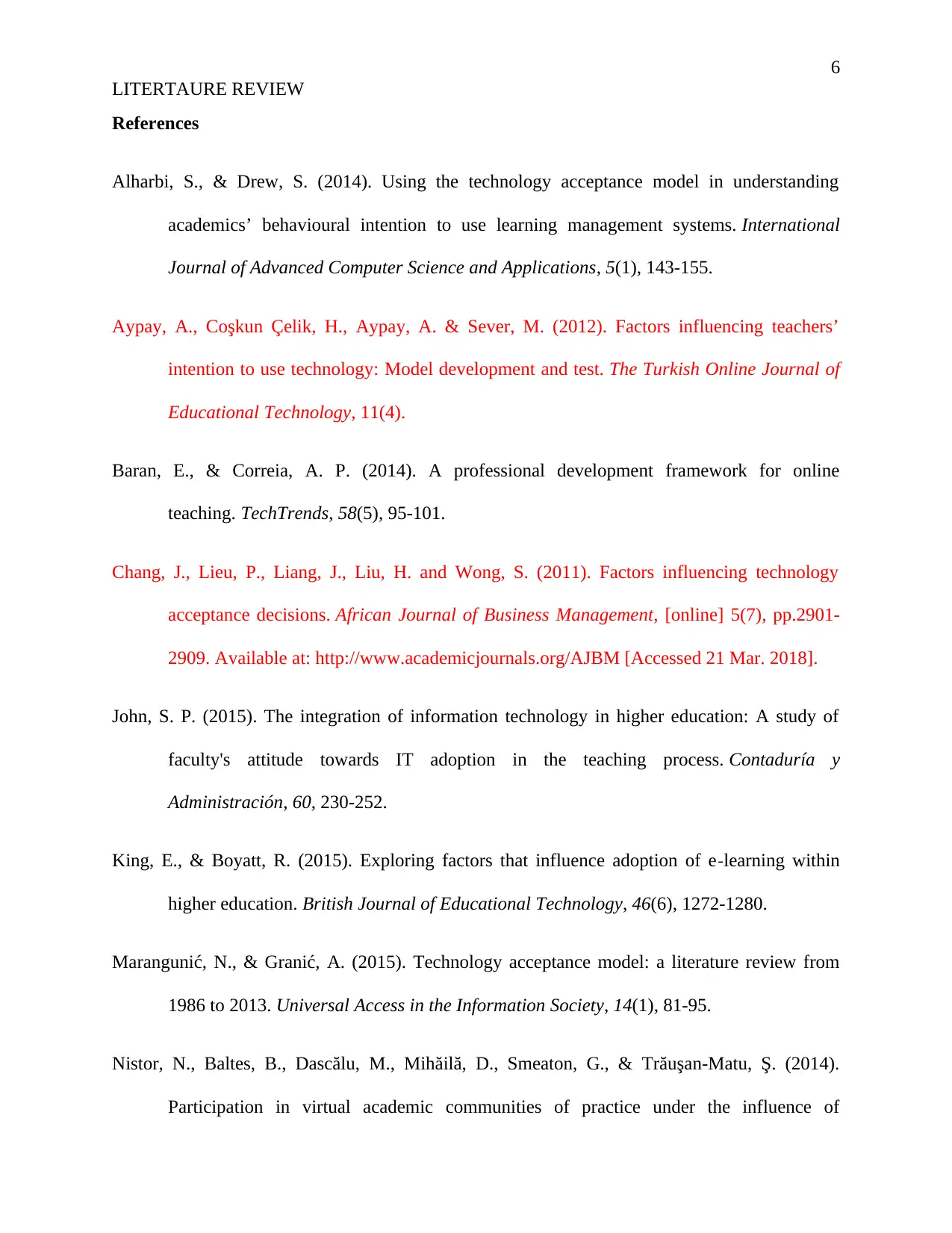
6
LITERTAURE REVIEW
References
Alharbi, S., & Drew, S. (2014). Using the technology acceptance model in understanding
academics’ behavioural intention to use learning management systems. International
Journal of Advanced Computer Science and Applications, 5(1), 143-155.
Aypay, A., Coşkun Çelik, H., Aypay, A. & Sever, M. (2012). Factors influencing teachers’
intention to use technology: Model development and test. The Turkish Online Journal of
Educational Technology, 11(4).
Baran, E., & Correia, A. P. (2014). A professional development framework for online
teaching. TechTrends, 58(5), 95-101.
Chang, J., Lieu, P., Liang, J., Liu, H. and Wong, S. (2011). Factors influencing technology
acceptance decisions. African Journal of Business Management, [online] 5(7), pp.2901-
2909. Available at: http://www.academicjournals.org/AJBM [Accessed 21 Mar. 2018].
John, S. P. (2015). The integration of information technology in higher education: A study of
faculty's attitude towards IT adoption in the teaching process. Contaduría y
Administración, 60, 230-252.
King, E., & Boyatt, R. (2015). Exploring factors that influence adoption of e‐learning within
higher education. British Journal of Educational Technology, 46(6), 1272-1280.
Marangunić, N., & Granić, A. (2015). Technology acceptance model: a literature review from
1986 to 2013. Universal Access in the Information Society, 14(1), 81-95.
Nistor, N., Baltes, B., Dascălu, M., Mihăilă, D., Smeaton, G., & Trăuşan-Matu, Ş. (2014).
Participation in virtual academic communities of practice under the influence of
LITERTAURE REVIEW
References
Alharbi, S., & Drew, S. (2014). Using the technology acceptance model in understanding
academics’ behavioural intention to use learning management systems. International
Journal of Advanced Computer Science and Applications, 5(1), 143-155.
Aypay, A., Coşkun Çelik, H., Aypay, A. & Sever, M. (2012). Factors influencing teachers’
intention to use technology: Model development and test. The Turkish Online Journal of
Educational Technology, 11(4).
Baran, E., & Correia, A. P. (2014). A professional development framework for online
teaching. TechTrends, 58(5), 95-101.
Chang, J., Lieu, P., Liang, J., Liu, H. and Wong, S. (2011). Factors influencing technology
acceptance decisions. African Journal of Business Management, [online] 5(7), pp.2901-
2909. Available at: http://www.academicjournals.org/AJBM [Accessed 21 Mar. 2018].
John, S. P. (2015). The integration of information technology in higher education: A study of
faculty's attitude towards IT adoption in the teaching process. Contaduría y
Administración, 60, 230-252.
King, E., & Boyatt, R. (2015). Exploring factors that influence adoption of e‐learning within
higher education. British Journal of Educational Technology, 46(6), 1272-1280.
Marangunić, N., & Granić, A. (2015). Technology acceptance model: a literature review from
1986 to 2013. Universal Access in the Information Society, 14(1), 81-95.
Nistor, N., Baltes, B., Dascălu, M., Mihăilă, D., Smeaton, G., & Trăuşan-Matu, Ş. (2014).
Participation in virtual academic communities of practice under the influence of
Paraphrase This Document
Need a fresh take? Get an instant paraphrase of this document with our AI Paraphraser
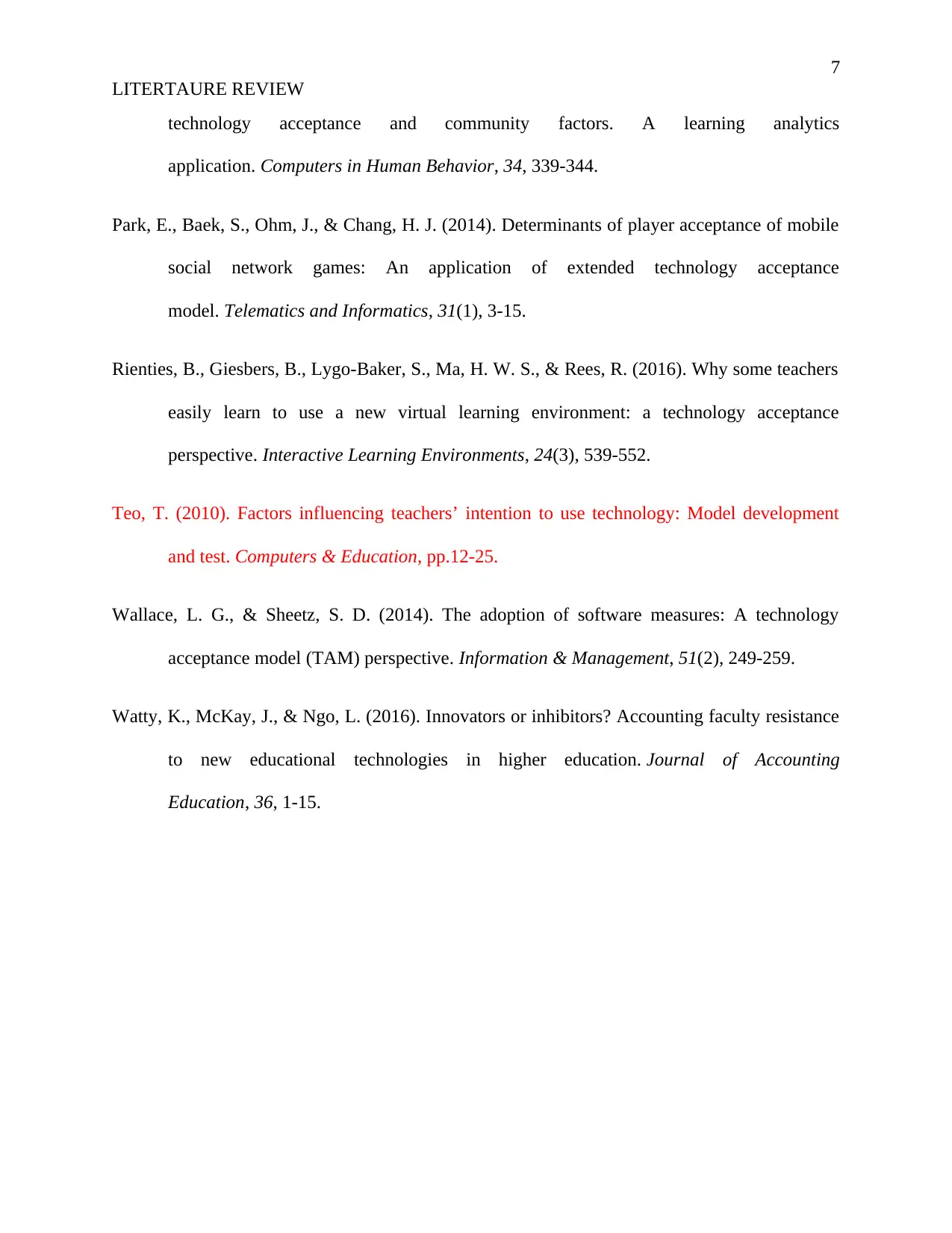
7
LITERTAURE REVIEW
technology acceptance and community factors. A learning analytics
application. Computers in Human Behavior, 34, 339-344.
Park, E., Baek, S., Ohm, J., & Chang, H. J. (2014). Determinants of player acceptance of mobile
social network games: An application of extended technology acceptance
model. Telematics and Informatics, 31(1), 3-15.
Rienties, B., Giesbers, B., Lygo-Baker, S., Ma, H. W. S., & Rees, R. (2016). Why some teachers
easily learn to use a new virtual learning environment: a technology acceptance
perspective. Interactive Learning Environments, 24(3), 539-552.
Teo, T. (2010). Factors influencing teachers’ intention to use technology: Model development
and test. Computers & Education, pp.12-25.
Wallace, L. G., & Sheetz, S. D. (2014). The adoption of software measures: A technology
acceptance model (TAM) perspective. Information & Management, 51(2), 249-259.
Watty, K., McKay, J., & Ngo, L. (2016). Innovators or inhibitors? Accounting faculty resistance
to new educational technologies in higher education. Journal of Accounting
Education, 36, 1-15.
LITERTAURE REVIEW
technology acceptance and community factors. A learning analytics
application. Computers in Human Behavior, 34, 339-344.
Park, E., Baek, S., Ohm, J., & Chang, H. J. (2014). Determinants of player acceptance of mobile
social network games: An application of extended technology acceptance
model. Telematics and Informatics, 31(1), 3-15.
Rienties, B., Giesbers, B., Lygo-Baker, S., Ma, H. W. S., & Rees, R. (2016). Why some teachers
easily learn to use a new virtual learning environment: a technology acceptance
perspective. Interactive Learning Environments, 24(3), 539-552.
Teo, T. (2010). Factors influencing teachers’ intention to use technology: Model development
and test. Computers & Education, pp.12-25.
Wallace, L. G., & Sheetz, S. D. (2014). The adoption of software measures: A technology
acceptance model (TAM) perspective. Information & Management, 51(2), 249-259.
Watty, K., McKay, J., & Ngo, L. (2016). Innovators or inhibitors? Accounting faculty resistance
to new educational technologies in higher education. Journal of Accounting
Education, 36, 1-15.
1 out of 8
Related Documents
Your All-in-One AI-Powered Toolkit for Academic Success.
+13062052269
info@desklib.com
Available 24*7 on WhatsApp / Email
![[object Object]](/_next/static/media/star-bottom.7253800d.svg)
Unlock your academic potential
Copyright © 2020–2025 A2Z Services. All Rights Reserved. Developed and managed by ZUCOL.





